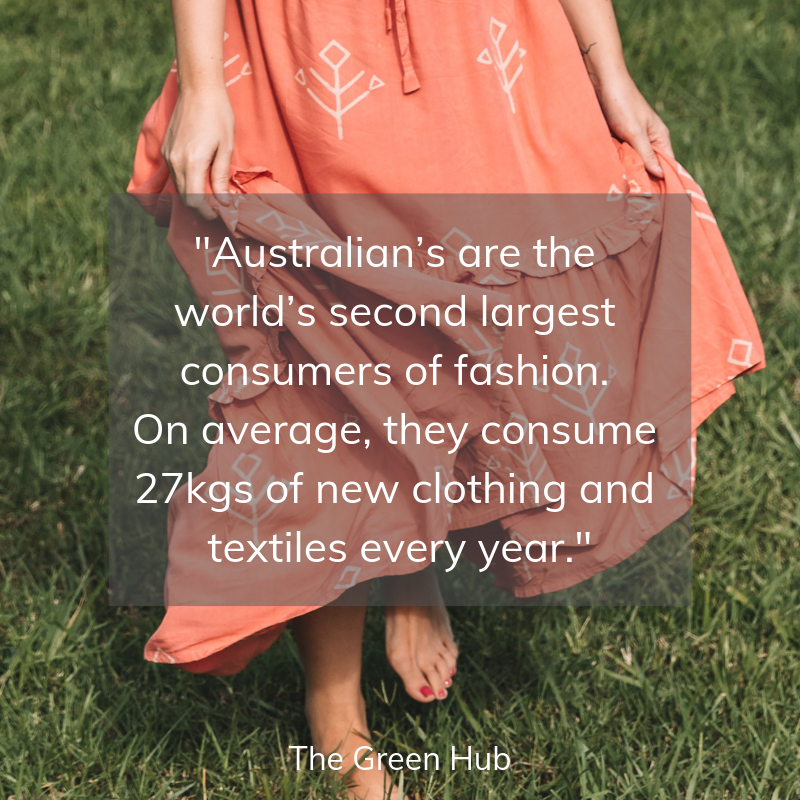36 Facts About Fast Fashion That Will (hopefully) Inspire You to Embrace the Slow Fashion Movement
Kira Simpson
It’s a 2.5 trillion dollar industry and society is consuming it at a rate like never before.
Meet Fast Fashion
The model relies on brands churning out new collections every month, sometimes every week, or in the case of fast fashion giants such as H&M and Zara, new styles land on the shop floor almost every day.
But what exactly is fast fashion?

FAST FASHION
Fast Fashion is cheaply produced, poorly constructed clothing that copies the latest catwalk styles, pumped quickly through stores to maximise current trends.
“Fast fashion can be defined as cheap, trendy clothing, that samples ideas from the catwalk or celebrity culture and turns them into garments in high street stores at breakneck speed.” – Good On You
Being trend-driven, fast fashion plays on our insecurities of wanting to look good and ‘keep up with the Joneses.’ It’s a toxic industry where the people who are making the clothing and the environment are paying a high price.
Hopefully, these facts about the fast fashion industry that will inspire you to embrace the slow and sustainable fashion movement.

1. “Eighty billion pieces of clothing are consumed globally every year.” – 1 Million Women
2. “Global clothing production has doubled in the past 15 years, with garments on average being worn much less and discarded quicker than ever before.” – Ellen MacArthur Foundation
3. “Australian’s are the world’s second-largest consumers of fashion. On average, they consume 27kgs of new clothing and textiles every year.” – ABC
4. “We are increasingly disconnected from the people who make our clothing as 97% of items you’re overseas. There are roughly 40 million garment workers in the world today; many of whom do not share the same rights or protections that many people in the West do. They are some of the lowest paid workers in the world and roughly 85% of all garment workers are women.” – The True Cost
5 .“Nearly 70 million barrels of oil are used each year to make the world’s polyester fiber, which is now the most commonly used fiber in our clothing. But it takes more than 200 years to decompose.” – Forbes
6. “Globally, we now consume about 80 billion new pieces of clothing every year—400% more than we were consuming just two decades ago” – University of Queensland
7. “Nine out of ten workers interviewed in Bangladesh cannot afford enough food for themselves and their families, forcing them to regularly skip meals and eat inadequately, or go into debt.” – Oxfam Made in Poverty Report
8. “Fast fashion companies design clothes that fall apart quickly. They pursue a strategy called ‘Planned obsolescence’. This means to design garments to become unfashionable, wear out, lose shape or fall to pieces easily to force consumers to keep buying new clothes.” – Be Global Fashion Network
9. “Millennials (people born after 1981) are twice as likely as baby boomers to toss clothing because it is unfashionable or they are bored of wearing it.” – YouGov Omnibus
10. “In Australia, where the demand for textiles is one of the highest per capita in the world, the fast fashion sector grew by 19.5 percent over five years to $AUS1.8 billion ($US1.4 billion) in 2017-18.” – SBS
11. “20,000 LITERS. The amount of water needed to produce one kilogram of cotton; equivalent to a single t-shirt and pair of jeans.” – WWF
12. “Australians buy an average of 27 kilograms of new textiles each year and then discard about 23 kilograms* into landfill – and two-thirds of those discards are manmade synthetic/plastic fibers that may never break down.” Textile Beat
13. “Paying living wages to garment workers would add just one percent on average to the retail price of a piece of clothing.” – What She Makes
14. “In 2017 it was revealed that fashion behemoth H&M — which has made much of its green agenda with recycling points in stores and what it calls a Conscious Collection — burned about 19 tons of obsolete clothing (the equivalent to 50,000 pairs of jeans).” – Huffington Post
15. “One-in-six people work in the global fashion industry.” – 1 Million Women
16. “250,000 Indian cotton farmers have killed themselves in the last 15 years due to the stress of debt they accumulated through buying genetically modified cotton seeds to keep up with demand.” – The True Cost
17. “The fashion industry is designed to make you feel “out of trend” after one week. Once upon a time, there were two fashion seasons: Spring/Summer and Fall/Winter. Fast forward to 2014 and the fashion industry is churning out 52 “micro-seasons” per year. With new trends coming out every week, the goal of fast fashion is for consumers to buy as many garments as possible, as quickly as possible.” – Overdressed: The Shockingly High Cost of Cheap Fashion
18. “Fast fashion giants make clothing to fall apart: they are obsessed with the bottom line, so will do anything to make you buy more clothes.” – Huffington Post
19. “Approximately 7,000 liters of water are needed to produce one pair of jeans (the amount of water one individual drinks in 5-6 years).” – Sustainable Fashion Matterz
20. “On 24 April 2013, the Rana Plaza building in Bangladesh collapsed. 1,138 people died and another 2,500 were injured, making it the fourth largest industrial disaster in history. There were five garment factories in Rana Plaza all manufacturing fast fashion for big global brands.” – Fashion Revolution
21. “More than 90% of that cotton is now genetically modified, using vast amounts of water as well as chemicals. Cotton production is now responsible for 18% of worldwide pesticide use and 25% of total insecticide use.” – The True Cost
22. “A single t-shirt takes 2,700 liters of water to make. The same amount of water an average person drinks over the course of 900 days.” – World Wild Life
23. “Australian, UK, USA, or New Zealand made, does not mean it is fair trade made; garment workers in the western world are exploited too.” – Overdressed by Elizabeth L Cline
24. “Only 10% of the clothes people donate to thrift stores or charities get sold, the rest goes to landfill.” – 1 Million Women
25. “85% of the plastic pollution in the ocean is due to microfibers from synthetic clothing.” – Dr. Mark Browne
26. “Clothing made from polyester can take up to 200 years to break down.”- ABC
27. “The average woman has $550 of unworn clothing in her closet having never worn at least 20 percent of the items in their wardrobes.” – Huffington Post Survey
28. “On current trend, the number of plastic microfibres entering the ocean between 2015 and 2050 could accumulate to an excess of 22 million tonnes – about two-thirds of the plastic-based fibres currently used to produce garments annually” – Ellen MacArthur Foundation
29. “Farmers in China close to garment factories ‘joke’ about being able to tell what colour will be ‘in’ next season by looking at the shade of their rivers.” – Refinery29
30. “When natural fibers, like cotton, linen, and silk, or semi-synthetic fibers created from plant-based cellulose, like rayon, Tencel and modal, are buried in a landfill, in one sense they act like food waste, producing the potent greenhouse gas methane as they degrade. But unlike banana peels, you can’t compost old clothes, even if they’re made of natural materials.” – Newsweek
31. “Fast fashion garments, which we wear less than 5 times and keep for 35 days, produce over 400% more carbon emissions per item per year than garments worn 50 times and kept for a full year.” -Forbes
32. “Cotton represents nearly half of the total fiber used to make clothing today. More than 90% of that cotton is now genetically modified, using vast amounts of water as well as chemicals. Cotton production is now responsible for 18% of worldwide pesticide use and 25% of total insecticide use.” – The True Cost
33. “Only 9 percent of Australian fashion brands pay their workers a living wage.” – Baptist World Aid Report
34. “Australian charitable recycling organisations are spending a staggering $13 million per year sending unusable donations to landfill. About 60,000 tonnes.” – ABC
35. “Fashion brands continue to use far more virgin resources than recycled ones.” – Quartz
36. “Fashion’s consumption of resources – especially water and oil – is projected to double by 2030.” – Common Objective


